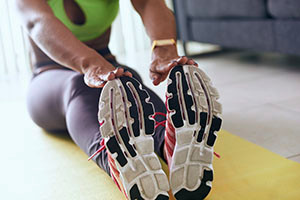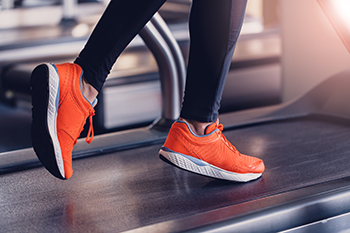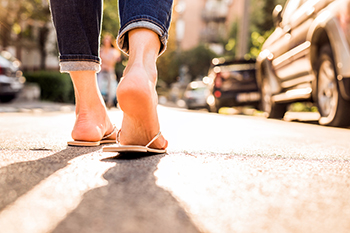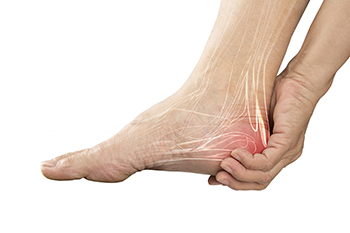Items filtered by date: May 2023
How to Know if You Have a Plantar Fibroma

A plantar fibroma causes soft tissue swelling in the sole of the foot. Sometimes when a patient has this affliction, one or more nodules can form in the soft tissue of the feet. It can happen in one foot or both feet at the same time. This condition can cause painful swelling in the feet and walking can be difficult. Plantar fibromas can be confused with benign Morton neuromas, cysts or more serious and malignant sarcomas. If you have swelling or uncomfortable foot nodules, it is strongly suggested that you make an appointment with a podiatrist. This foot and ankle expert can provide a proper diagnosis using radiographic imaging and suggest appropriate treatment.
A plantar fibroma may disrupt your daily activities. If you have any concerns, contact Dr. Joshua David Scoll of Pennsylvania. Our doctor can provide the care you need to keep you pain-free and on your feet.
Plantar Fibroma
A plantar fibroma is a fibrous knot in the arch of the foot. It is embedded in the plantar fascia which is a band of tissue that extends from the heel to the toes along the bottom of the foot. There can be multiple plantar fibromas in the feet at the same time. There are no known causes for this condition. If you have a plantar fibroma, there will be a bump in the arch of your foot that cannot be missed. Any associated pain is most often due to a shoe rubbing against the nodule. Non-surgical options, such as steroid injections, physical therapy, and orthotics should be tried first. Surgery is a last resort and is the only thing that will remove a plantar fibroma entirely. Consult with a podiatrist for a proper diagnosis and to determine the treatment regimen that is right for you.
What Causes a Plantar Fibroma?
While there are no specific causes identified, a plantar fibroma can possibly come from genetic predisposition or the formation of scar tissue that forms from healing the tears in the plantar fascia.
What Are the Symptoms of a Plantar Fibroma?
There will be a noticeable lump in the arch of the foot that may or may not cause pain. If pain is felt, it is typically because a shoe is rubbing up against the lump or when walking or standing barefoot.
Treatment and Prevention
A plantar fibroma will not disappear without treatment, but it can get smaller and be a non-issue. If pain persists, a podiatrist examines the foot and when the arch of the foot is pressed, pain can be felt down to the toes. An MRI or biopsy might be performed to help diagnose or evaluate the plantar fibroma. The following non-surgical options are generally enough to reduce the size and pain of these nodules:
- Steroid injections
- Orthotics
- Physical therapy to help apply anti-inflammatory creams on the bump
Surgery is considered if the mass increases in size and the patient continues to feel pain after non-surgical methods are tried.
If you have any questions please feel free to contact one of our offices located in Philadelphia, Bensalem, and Fairless Hills, PA . We offer the newest diagnostic tools and technology to treat your foot and ankle needs.
Simple Methods That Can Prevent Running Injuries

People who enjoy running and jogging are aware of how a running injury can interrupt this hobby. The importance of preventing running injuries ranks high among runners, and there are effective methods that can accomplish this. It is beneficial to stay hydrated by drinking plenty of water, which may help to prevent foot cramps. Stretching before and after running is effective in keeping the muscles limber, in addition to wearing running shoes that fit correctly. Many runners find it is better for their body to gradually change running surfaces, if desired, and to recover for an adequate amount of time. There are several types of running injuries, which may be prevented by taking care of the body. If you would like more information about how to do this, it is suggested that you consult with a podiatrist who can present you with effective tips on how to prevent running injuries.
All runners should take extra precaution when trying to avoid injury. If you have any concerns about your feet, contact Dr. Joshua David Scoll of Pennsylvania. Our doctor will treat your foot and ankle needs.
How to Prevent Running Injuries
There are a lot of mistakes a runner can make prior to a workout that can induce injury. A lot of athletes tend to overstretch before running, instead of saving those workouts for a post-run routine. Deep lunges and hand-to-toe hamstring pulls should be performed after a workout instead of during a warmup. Another common mistake is jumping into an intense routine before your body is physically prepared for it. You should try to ease your way into long-distance running instead of forcing yourself to rush into it.
More Tips for Preventing Injury
- Incorporate Strength Training into Workouts - This will help improve the body’s overall athleticism
- Improve and Maintain Your Flexibility – Stretching everyday will help improve overall performance
- “Warm Up” Before Running and “Cool Down” Afterward – A warm up of 5-10 minutes helps get rid of lactic acid in the muscles and prevents delayed muscle soreness
- Cross-Training is Crucial
- Wear Proper Running Shoes
- Have a Formal Gait Analysis – Poor biomechanics can easily cause injury
If you have any questions, please feel free to contact one of our offices located in Philadelphia, Bensalem, and Fairless Hills, PA . We offer the newest diagnostic and treatment technologies for all your foot care needs.
Various Methods to Exercise the Feet

The feet can become strong when a consistent exercise regime is practiced. There are 26 bones, numerous tendons, and several ligaments that comprise each foot. Yoga has effective exercise and stretching techniques that target strengthening the feet. A heel sit is done by sitting on one foot at a time while kneeling on the other foot, and a stretch can be felt as the back foot is elongated. Calf raises can be equally as successful in keeping the feet strong. Many people enjoy having reflexology sessions, which are done by exerting pressure on various areas of the foot. This may be an effective method of strengthening the feet. Research has indicated that people who enjoy deadlifting may benefit by performing this type of strength training while barefoot. If you would like to learn more about what type of exercises can help the feet, it is suggested that you confer with a podiatrist who can provide you with the information you are seeking.
Exercising your feet regularly with the proper foot wear is a great way to prevent injuries and build strength. If you have any concerns about your feet, contact Dr. Joshua David Scoll from Pennsylvania. Our doctor can provide the care you need to keep you pain-free and on your feet.
Exercise for Your Feet
Exercise for your feet can help you gain strength, mobility and flexibility in your feet. They say that strengthening your feet can be just as rewarding as strengthening another part of the body. Your feet are very important, and we often forget about them in our daily tasks. But it is because of our feet that are we able to get going and do what we need to. For those of us fortunate enough to not have any foot problems, it is an important gesture to take care of them to ensure good health in the long run.
Some foot health exercises can include ankle pumps, tip-toeing, toe rises, lifting off the floor doing reps and sets, and flexing the toes. It is best to speak with Our doctor to determine an appropriate regimen for your needs. Everyone’s needs and bodies are different, and the activities required to maintain strength in the feet vary from individual to individual.
Once you get into a routine of doing regular exercise, you may notice a difference in your feet and how strong they may become.
If you have any questions please feel free to contact one of our offices located in Philadelphia, Bensalem, and Fairless Hills, PA . We offer the newest diagnostic and treatment technologies for all your foot and ankle needs.
Do Your Child's Feet Hurt?
Flip-Flops and Heel Pain

Flip-flops are often worn at the beach or around pools, but they are also worn as regular summertime footwear. These sandals are often thin-soled and offer little arch and foot cushioning support. Wearing these types of shoes long-term can lead to painful plantar fasciitis, which is a condition that affects the plantar fascia. This is the band of tissue that runs from the heel to the toes on the bottom of the foot, and may endure small tears or become overstretched. Plantar fasciitis can cause severe foot pain, particularly with the first steps after arising from sleep, or from walking for a prolonged period. If plantar fasciitis is not treated, a heel spur can develop, further irritating the foot. Flip-flops should be left for protecting feet in locker rooms or around the water, and more supportive shoes should be worn for other activities. If you have developed plantar fasciitis from wearing flip-flops, it is suggested that you consult with a podiatrist who can help you with treatment options, and recommend better summertime footwear.
Flip-flops can cause a lot of problems for your feet. If you have any concerns about your feet or ankles, contact Dr. Joshua David Scoll from Pennsylvania. Our doctor will assist you with all of your foot and ankle needs.
Flip-Flops and Feet
Flip-flops have managed to become a summer essential for a lot of people. While the shoes may be stylish and easy to slip on and off, they can be dangerous to those who wear them too often. These shoes might protect you from fungal infections such as athlete’s foot, but they can also give you foot pain and sprained ankles if you trip while wearing them.
When Are They Okay to Wear?
Flip-flops should only be worn for very short periods of time. They can help protect your feet in places that are crawling with fungi, such as gym locker rooms. Athlete’s foot and plantar warts are two common fungi that flip-flops may help protect your feet against.
Why Are They Bad for My Feet?
These shoes do not offer any arch support, so they are not ideal for everyday use. They also do not provide shock absorption or heel cushioning which can be problematic for your feet. Additionally, you may suffer from glass cuts, puncture wounds, and stubbed toes since they offer little protection for your feet.
More Reasons Why They Are Bad for Your Feet
- They Slow You Down
- May Cause Blisters and Calluses
- Expose Your Feet to Bacteria
If you have any questions, please feel free to contact one of our offices located in Philadelphia, Bensalem, and Fairless Hills, PA . We offer the newest diagnostic and treatment technologies for all your foot care needs.
Heel Pain Causes

Having heel pain can cause difficulty in pursuing daily activities. It can happen from enduring a sprain or fracture, or there may be existing medical conditions that can lead to getting heel pain. Out of the 26 bones in each foot, the heel bone is the largest. Wearing shoes that do not fit correctly may cause common heel conditions, such as plantar fasciitis or heel spurs, to develop. Additional forms of heel pain can be from bursitis, or if an Achilles tendon injury has occurred. Swelling and redness may accompany heel pain, and it is often difficult to walk. Mild relief may be found when the affected foot is frequently elevated, and shoes that are worn fit properly. Some patients choose to put a heel lift or a shoe insert inside the shoe, which may help to reduce existing pain. If you have heel pain, it is strongly suggested that you consult with a podiatrist as quickly as possible. This type of doctor can determine what the cause is, and offer you the treatment method that is best for you.
Many people suffer from bouts of heel pain. For more information, contact Dr. Joshua David Scoll of Pennsylvania. Our doctor can provide the care you need to keep you pain-free and on your feet.
Causes of Heel Pain
Heel pain is often associated with plantar fasciitis. The plantar fascia is a band of tissues that extends along the bottom of the foot. A rip or tear in this ligament can cause inflammation of the tissue.
Achilles tendonitis is another cause of heel pain. Inflammation of the Achilles tendon will cause pain from fractures and muscle tearing. Lack of flexibility is also another symptom.
Heel spurs are another cause of pain. When the tissues of the plantar fascia undergo a great deal of stress, it can lead to ligament separation from the heel bone, causing heel spurs.
Why Might Heel Pain Occur?
- Wearing ill-fitting shoes
- Wearing non-supportive shoes
- Weight change
- Excessive running
Treatments
Heel pain should be treated as soon as possible for immediate results. Keeping your feet in a stress-free environment will help. If you suffer from Achilles tendonitis or plantar fasciitis, applying ice will reduce the swelling. Stretching before an exercise like running will help the muscles. Using all these tips will help make heel pain a condition of the past.
If you have any questions please contact one of our offices located in Philadelphia, Bensalem, and Fairless Hills, PA . We offer the newest diagnostic and treatment technologies for all your foot and ankle needs.

